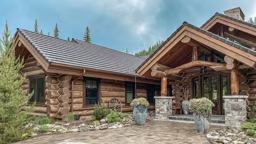
Home Details
Square footage: 1,500 (including loft)Bedrooms: 2
Baths: 1
Designer/Log Provider: Ward Cedar Log Homes
Consider convenience. From maintenance to mobility, a single-level home can make things easier for all walks of life. But you also want options. Whether it’s hosting house guests, adding storage or accommodating a growing family, a little extra space can increase both a home’s versatility and its value.
The Georgetown, a one-level floor plan from Maine’s Ward Cedar Log Homes, marries the simplicity of single-level living with the bonus of an additional loft area. Intended as a second bedroom, it could just as easily serve as a study or general overflow space.
Ron Silliboy, director of sales and marketing at Ward Cedar Log Homes, spoke with us about the Georgetown’s benefits:
“Most people who build log homes are going to be in them for a very long time,” he states. “A single-level plan has the advantage for older residents to not have to climb stairs.”
Older folks aren’t the only ones who profit. A one-story home also provides safety for small children and easy accommodations for mobility-impaired residents or visitors. Plus, keeping up with home maintenance is easier, as you can access all areas with a ladder and feel safe.
The Georgetown
Plan: Courtesy of Ward Cedar Log Homes
1. The small loft overlooks the living room and dining room while it adds sleeping space.
2. A combined mudroom and laundry reduces square footage and is a great cost-saving technique.
3. Spaces, like the entryway, can be reconfigured to make the home feel larger.
4. A centrally located hearth provides coziness and comfort to both the living room and dining room.
5. Two porches connected by a large deck offer low-cost exterior space perfect for entertaining and outdoor living.

The Low Down
The original Georgetown was built in Connecticut as a custom-designed home. Ward liked the finished product so much they incorporated the floor plan into their stock roster.
The plan’s cozy square footage uses several techniques to give the home a spacious feel, but natural light is the key to making each room feel more open. Nine-foot-tall French wood doors and gabled windows connect occupants with the outdoor vistas. “The best location for this home is a rural area — somewhere in the country or a small town,” Ron says.
The Inside Scoop
A one-story home can be a good choice for people in all sorts of situations. If you’re on the fence about single-level living, consider these factors:Back to back.
If you have two bathrooms, have them back up to each other. It consolidates plumbing lines and makes installation easier. For even more cost savings, situate the kitchen, which has plenty of plumbing itself, nearby.
Play it cool.
In the summer, cooling a full two-story home can take time and energy. One-story homes can be heated and cooled evenly, saving a bundle on energy costs.
Shuffle it.
Design adjustments are often easier with a single-story plan. “Some people rearrange the entryway to make the home slightly larger,” says Ron.
Look outside.
The plan offers nearly 600 square feet of porches and decks, which adds livable space at a reduced cost.








_11868_2024-09-17_08-44-256x288.avif)


